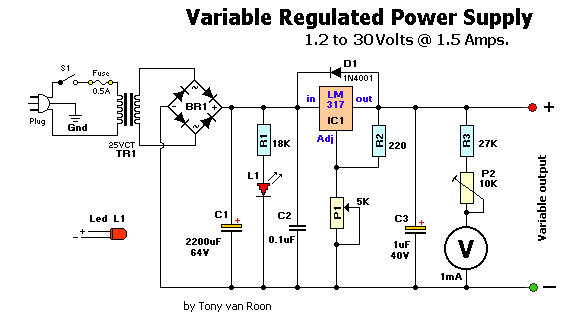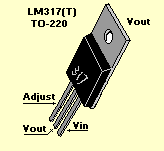
Parts List
BR1 = Bridge Rectifier, 100V - 3A C1 = 2200 µF, 63V
IC1 = LM317, adjustable regulator C2 = 0.1 µF
V = Meter, 30V, Ri = 85 ohm C3 = 1µF, 40V
TR1 = Transformer, 25V, 2A Plug = 3-wire plug & cord
R1 = 18K, 5% S1 = On-Off toggle switch
R2 = 220 ohm, 5% D1 = 1N4001
R3 = 27K, 5% Fuse = 110V, 500mA, slow-blow
P1 = 5K, potentiometer FuseHolder, wire, solder, case, knob for P1
P2 = 10K, 10-turn trim-pot Red & Black Banana Jacks
 Some Notes:
This is a simple, but low-ripple powersupply, and an excellent project if you're
starting out in electronics. It will suit your needs for most of your bench
testing and prototype applications. The output is adjustable from 1.2 volts to
about 30 volts. Maximum current is about 1.5 amps which is also sufficient for
most of your tinkering. It is relatively easy to build and can be pretty cheap
if you have some or all the required parts. A printed circuit board is not
included and I'm not planning on adding one since the whole thing can easily be
build on perferated or vero board. Or buy one of Radio Shack/Tandy's
experimentors boards (#276-150). Suit yourself. The meter and the transformer
are the money suckers, but if you can scrounge them up from somewhere it will
reduce the cost significantly. BR1 is a full-wave bridge rectifier. The two '~'
denotes 'AC' and are connected to the 25vac output coming from the transformer.
IC1 is a 3-pin, TO-220 model. Be sure to put a cooling rib on IC1, at it's max
1.5 A current it quickly becomes very hot...
Some Notes:
This is a simple, but low-ripple powersupply, and an excellent project if you're
starting out in electronics. It will suit your needs for most of your bench
testing and prototype applications. The output is adjustable from 1.2 volts to
about 30 volts. Maximum current is about 1.5 amps which is also sufficient for
most of your tinkering. It is relatively easy to build and can be pretty cheap
if you have some or all the required parts. A printed circuit board is not
included and I'm not planning on adding one since the whole thing can easily be
build on perferated or vero board. Or buy one of Radio Shack/Tandy's
experimentors boards (#276-150). Suit yourself. The meter and the transformer
are the money suckers, but if you can scrounge them up from somewhere it will
reduce the cost significantly. BR1 is a full-wave bridge rectifier. The two '~'
denotes 'AC' and are connected to the 25vac output coming from the transformer.
IC1 is a 3-pin, TO-220 model. Be sure to put a cooling rib on IC1, at it's max
1.5 A current it quickly becomes very hot...
All the parts can be obtained
from your local Radio Shack or Tandy store. The physical size of the power
supply case depends largely on the size of the meter & transformer. But
almost anything will do. Go wild.
Circuit Description: The 110V-AC
coming from the powercord is fed to the transformer TR1 via the on-off switch
and the 500mA fuse. The 30vac output (approximately) from the transformer is
presented to the BR1, the bridge-rectifier, and here rectified from AC
(Alternating Current) to DC (Direct Current). If you don't want to spend the
money for a Bridge Rectifier, you can easily use four general purpose 1N4004
diodes. The pulsating DC output is filtered via the 2200µF capacitor (to make it
more manageable for the regulator) and fed to 'IN'-put of the adjustable LM317
regulator (IC1). The output of this regulator is your adjustable voltage of 1.2
to 30volts varied via the 'Adj' pin and the 5K potmeter P1. The large value of
C1 makes for a good, low ripple output voltage.
Why exactly 1.2V and not
0-volt? Very basic, the job of the regulator is two-fold; first, it compares the
output voltage to an internal reference and controls the output voltage so that
it remains constant, and second, it provides a method for adjusting the output
voltage to the level you want by using a potentriometer. Internally the
regulator uses a zener diode to provide a fixed reference voltage of 1.2 volt
across the external resistor R2. (This resistor is usually around 240 ohms, but
220 ohms will work fine without any problems). Because of this the voltage at
the output can never decrease below 1.2 volts, but as the potentiometer (P1)
increases in resistance the voltage accross it, due to current from the
regulator plus current from R2, its voltage increases. This increases the output
voltage.
D1 is a general purpose 1N4001 diode, used as a feedback blocker. It
steers any current that might be coming from the device under power around the
regulator to prevent the regulator from being damaged. Such reverse currents
usually occur when devices are powered down.
The 'ON' Led will be lit via the
18K resistor R1. The current through the led will be between 12 - 20mA @ 2V
depending on the type and color Led you are using. C2 is a 0.1µF (100nF)
decoupler capacitor to filter out the transient noise which can be induced into
the supply by stray magnetic fields. Under normal conditions this capacitor is
only required if the regulator is far away from the filter cap, but I added it
anyway. C3 improves transient response. This means that while the regulator may
perform perfectly at DC and at low frequencies, (regulating the voltage
regardless of the load current), at higher frequencies it may be less effective.
Adding this 1 µF capacitor should improve the response at those
frequencies.
R3 and the trimmer pot (P2) alows you to 'zero' your meter to a
set voltage. The meter is a 30Volt type with an internal resistance of 85 ohms.
I you have or obtained a meter with a different Ri (internal resistance) you
will have to adjust R3 to keep the current of meter to 1mA. Just another note in
regards this meter, use the reading as a guideline. The reading may or may not
be off by about 0.75volts at full scale, meaning if your meter indicates 30
volts it may be in reality almost 31 volts or 29 volts. If you need a more
precies voltage, then use your multimeter.
Construction: Because
of the few components you can use a small case but use whatever you have
available.
I used a power cord from a computer and cut the computer end off.
All computer power cords are three-prong. The ground wire, which is connected to
the middle pin of the power plug is connected to the chassis. The color of the
ground-wire is either green or green/yellow. It is there for your protection if
the 110vac accidentally comes in contact with the supply housing (case). BE
CAREFUL always to disconnect the powerplug when you working inside the chassis.
If you choose to use an in-line, or clip-type fuseholder be sure to isolate it
with heat shrink or something to minimize accidental touching.
I use
perf-board (or Vero board) as a circuit board. This stuff is widely available
and comes relatively cheap. It is either made of some sort of fiber material or
Phenolic or Bakelite pcb. They all work great. Some Phenolic boards come with
copper tracks already on them which will make soldering the project together
easier.
I mounted the LM317(T) regulator on a heatsink. If you use a
metal/aluminum case you can mount it right to the metal case, insulated with the
mica insulator and the nylon washer around the mounting screw. Note that the
metal tab of the LM317 is connected internally to the 'Output' pin. So it has to
be insulated when mounting directly to the case. Use heat sink compound (comes
in transparent or white color) on the metal tab and mica insulator to maximize
proper heat transfer between LM317 and case/ or heatsink.
Drill the holes
for the banana jacks, on/off switch, and LED and make the cut-out for the meter.
It is best to mount everything in such a way that you are able to trouble-shoot
your circuit board with ease if needed. One more note about the on-off switch
S1, this switch has 110VAC power to it. After soldering, insulate the bare spots
with a bit of silicon gel. Works great and prevents electrical shock through
accidental touching.
If all is well, and you are finished assembling and
soldering everything, check all connections. Check capacitors C1 & C3 for
proper polarity (especially for C1, polarity reversal may cause explosion).
Hookup a multimeter to the power supply output jacks. Set the meter for DC
volts. Switch on S1 (led will light, no smoke or sparks?) and watch the meter
movement. Adjust the potentiometer until it reads on your multimeter 15Volts.
Adjust trimpot P2 until the meter also reads 15volts. When done, note any
discrepancies between your multimeter and the power supply meter at full scale
(max output). Maybe there is none, maybe there is a little, but you will be
aware of it. Good luck and have fun building!
Back to Circuits
page
Copyright © 2000 by Tony
van Roon


 Some Notes:
This is a simple, but low-ripple powersupply, and an excellent project if you're
starting out in electronics. It will suit your needs for most of your bench
testing and prototype applications. The output is adjustable from 1.2 volts to
about 30 volts. Maximum current is about 1.5 amps which is also sufficient for
most of your tinkering. It is relatively easy to build and can be pretty cheap
if you have some or all the required parts. A printed circuit board is not
included and I'm not planning on adding one since the whole thing can easily be
build on perferated or vero board. Or buy one of Radio Shack/Tandy's
experimentors boards (#276-150). Suit yourself. The meter and the transformer
are the money suckers, but if you can scrounge them up from somewhere it will
reduce the cost significantly. BR1 is a full-wave bridge rectifier. The two '~'
denotes 'AC' and are connected to the 25vac output coming from the transformer.
IC1 is a 3-pin, TO-220 model. Be sure to put a cooling rib on IC1, at it's max
1.5 A current it quickly becomes very hot...
Some Notes:
This is a simple, but low-ripple powersupply, and an excellent project if you're
starting out in electronics. It will suit your needs for most of your bench
testing and prototype applications. The output is adjustable from 1.2 volts to
about 30 volts. Maximum current is about 1.5 amps which is also sufficient for
most of your tinkering. It is relatively easy to build and can be pretty cheap
if you have some or all the required parts. A printed circuit board is not
included and I'm not planning on adding one since the whole thing can easily be
build on perferated or vero board. Or buy one of Radio Shack/Tandy's
experimentors boards (#276-150). Suit yourself. The meter and the transformer
are the money suckers, but if you can scrounge them up from somewhere it will
reduce the cost significantly. BR1 is a full-wave bridge rectifier. The two '~'
denotes 'AC' and are connected to the 25vac output coming from the transformer.
IC1 is a 3-pin, TO-220 model. Be sure to put a cooling rib on IC1, at it's max
1.5 A current it quickly becomes very hot...